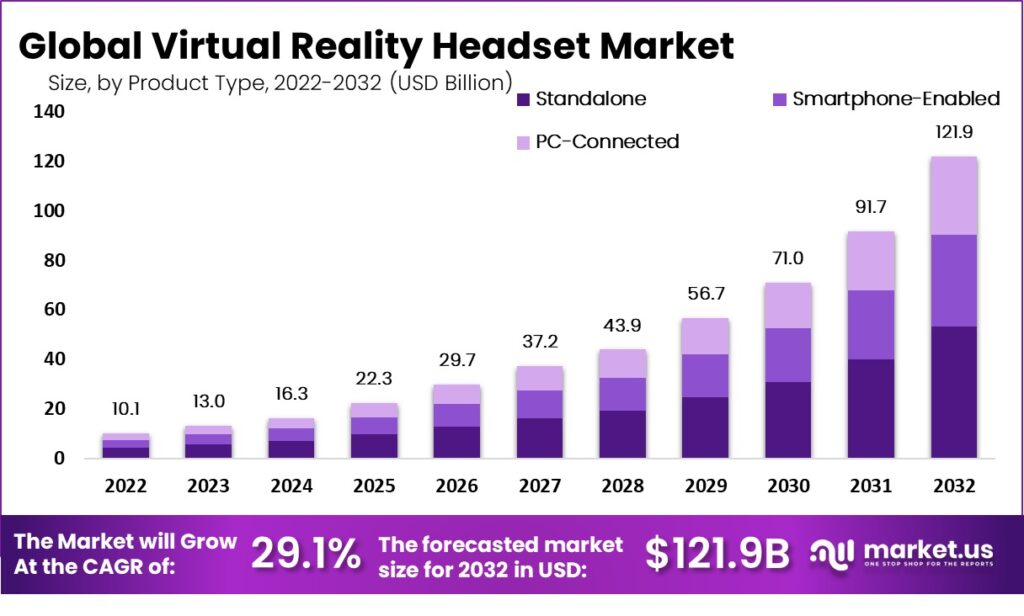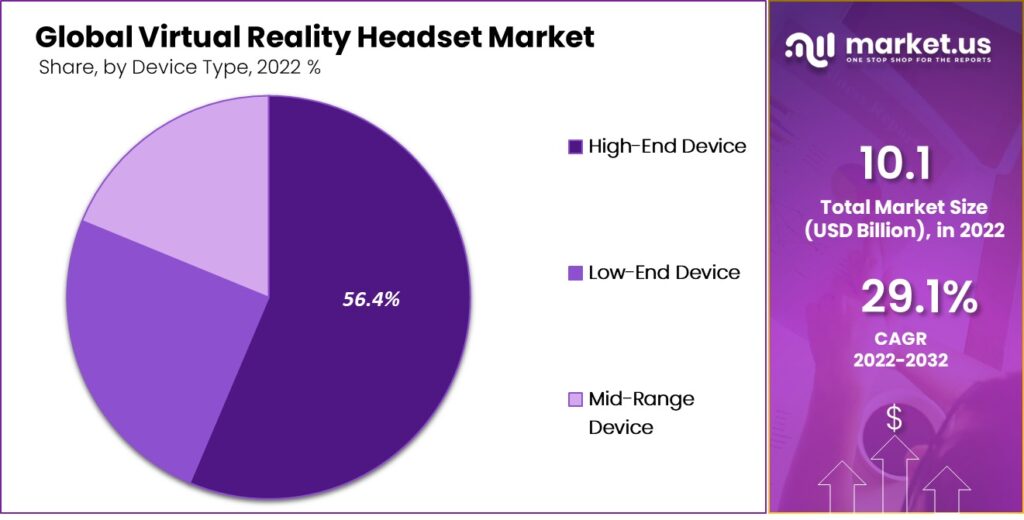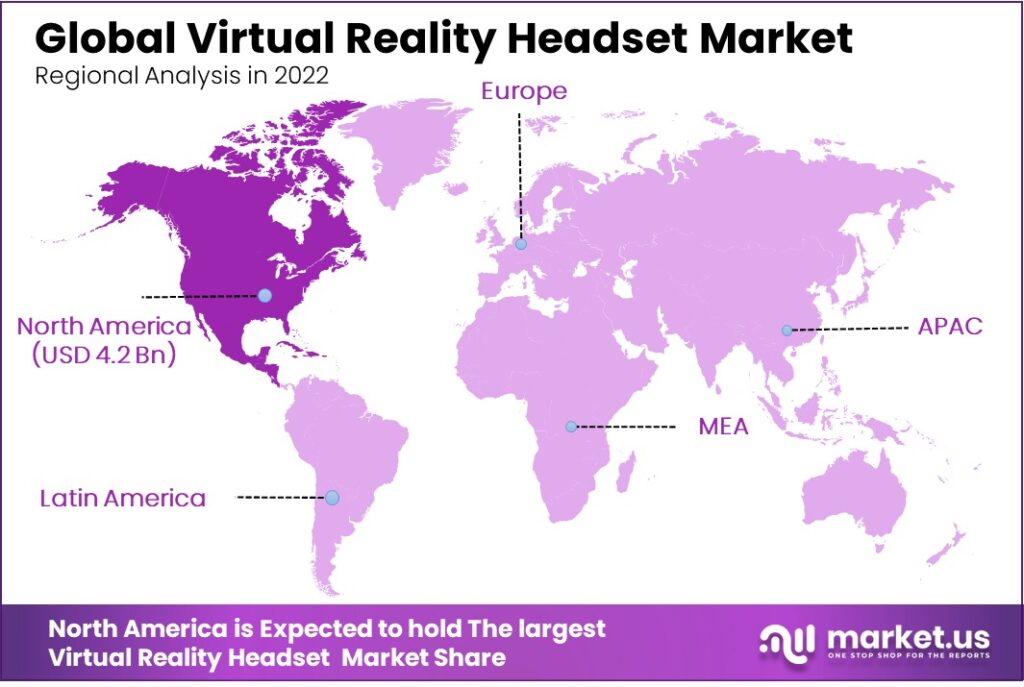Global Virtual Reality Headset Market By Product Type (Standalone, Smartphone-Enabled, and PC-Connected), By Device Type (Low-End Device, Mid-Range Device, and High-End Device), By End-Use Industry, By Region and Companies - Industry Segment Outlook, Market Assessment, Competition Scenario, Trends, and Forecast 2023-2032
- Published date: Nov. 2023
- Report ID: 106128
- Number of Pages: 394
- Format:
- keyboard_arrow_up
Quick Navigation
Report Overview
The valuation of Global Virtual Reality Headset Market is expected to surpass USD 121.9 billion by the year 2032 from USD 13 Billion in 2023, expanding steadily at the highest CAGR of 29.1%.
As the need for novel and captivating digital experiences grows, VR headsets have emerged as a perfect device to fulfill this demand. These technologically advanced devices transport users into digitally simulated environments, providing a profound sense of presence and engagement. The vibrant sector of technological innovation and market competition allows users to traverse the realms of imagination and practicality alike. As the boundaries of what is achievable within virtual environments continue to evolve, the Market is poised to further transform how individuals perceive, interact with, and derive value from the digital realm.
These sophisticated devices offer users simulated environments with heightened engagement. Industry leaders and agile startups compete to craft advanced, user-centric VR headsets, spanning tethered, standalone, and smartphone-linked types. VR’s fusion with augmented and mixed reality expands applications beyond entertainment by impacting education, healthcare, and remote collaboration.

Note: Actual Numbers Might Vary In The Final Report
Key Takeaways
- Market Valuation and Growth Rate: The Virtual Reality Headset Market is anticipated to reach a valuation of USD 121.9 billion by 2032, with a staggering Compound Annual Growth Rate (CAGR) of 29.1% from 2023 to 2032.
- Driving Factors: Continuous technological innovations are driving the growth of the market. Technological advancements in display resolution, tracking systems, and computational power have enhanced the quality of virtual reality experiences. Moreover, the increasing popularity of social and collaborative virtual reality experiences has expanded the market beyond individual consumers.
- Restraining Factors: The high cost of high-quality VR headsets and the requirement of compatible hardware to run these devices optimally act as significant restraints. Additionally, potential long-term effects on users’ health, such as discomfort, motion sickness, and eye strain, have raised regulatory and ethical concerns.
- Product Type Analysis: Standalone headsets lead the market, accounting for 43.6% of the major revenue share. This growth is attributed to their autonomous functionality and user-friendly approach, appealing to a broader consumer base. Smartphone-enabled headsets are expected to grow significantly due to the rising penetration of VR-enabled smartphones.
- Device Type Analysis: High-end devices dominate the market with a major revenue share of 56.4%. Their superior immersive experiences, advanced technology, and extensive content libraries cater to enthusiasts and professionals seeking top-notch quality. Low-end devices are anticipated to grow rapidly, driven by their affordability and immersive experience.
- End-Use Industry Analysis: The gaming industry leads the market, securing a major revenue share of 29.4%. VR headsets enhance gaming engagement through lifelike environments and interactive elements. The education industry is expected to grow at the fastest CAGR, driven by the high penetration and applications of VR for interactive learning.
- Regional Analysis: North America holds the major revenue share, dominating the market at 42.3%. The region’s robust technological infrastructure and a concentration of tech giants drive innovation. The Asia Pacific region is projected to grow at the fastest CAGR, supported by the advent of 5G technology and policy support for technology.
- Key Players: Major companies in the market, including Google LLC, Microsoft Corporation, HTC Corporation, HP Inc., Sony, Meta Platforms Inc., Samsung, Xiaomi, Lenovo, and LG Electronics Inc., are focusing on lowering the price of headsets and making them easily accessible. Recent developments include mergers, product innovations, and advancements in mixed reality headsets.
Driving Factor
Continuous Technological Innovations are fueling the growth.
Technological innovation remains a key driver for the market, with advancements in display resolution, tracking systems, and computational power enhancing the quality of virtual reality experiences. This has led to increased adoption not only in the gaming sector but also in areas such as healthcare, education, and automotive design, where VR offers valuable training, simulation, and design visualization capabilities.
Further, the increasing popularity of social and collaborative virtual reality experiences has boosted the demand for headsets that facilitate interpersonal interactions in virtual environments. This has widened the Market’s scope beyond individual consumers to encompass social groups and enterprise collaborations.
Furthermore, the increasing popularity of social and collaborative virtual reality experiences has spurred demand for headsets that facilitate interpersonal interactions in virtual environments. This has widened the Market’s scope beyond individual consumers to encompass social groups and enterprise collaborations.
Restraining Factor
High Cost
High-quality VR headsets often have a significant price tag, restricting budget-conscious consumers from entering the Market. The cost is further affected by the necessity of compatible hardware to run these devices optimally, which can be an additional financial burden for potential buyers. The prolonged usage of VR headsets can lead to discomfort, motion sickness, and eye strain. The potential long-term effects on users’ health, especially considering the prolonged exposure to screens and potentially disorienting experiences, have raised regulatory and ethical concerns.
Furthermore, the Market is not immune to competition from other emerging technologies, such as augmented reality and mixed reality. As these technologies gain traction, they pose an alternative avenue for consumers seeking immersive experiences
By Product Type Analysis
Standalone Headsets Leads the Market with Major Revenue Share.
Based on product type, the Market is classified into standalone, smartphone-enabled, and PC-connected. Among these product types, standalone leads the segment with 43.6% major revenue share in the Market. This growth of standalone headsets is due to their autonomous functionality, obviating the need for external devices. Its user-friendly approach ensures uncomplicated setup and usage, thereby appealing to a broader consumer base. After standalone headsets, smartphone-enabled are anticipated to grow at a significant CAGR over the forecast period. The rising penetration of advanced VR-enabled smartphones is expected to drive the growth of smartphone-enabled headsets in the market.
By Device Type Analysis
High-end Device Leads the Device Type Segment in the Market by Covering Major Revenue Share.
On the basis of device type, the market is classified into, low-end devices, mid-range devices, and high-end devices. From these device types, high-end device dominates the Market by covering the major revenue share of 56.4% of the Market. This massive growth of high-end devices is owing to the advantages offered by these devices. High-end devices offer superior immersive experiences due to advanced technology, higher-resolution displays, precise tracking, and extensive content libraries. Their enhanced capabilities cater to enthusiasts and professionals seeking top-notch quality.
Furthermore, high-end VR headsets often integrate additional features like ergonomic design and compatibility with external accessories, enhancing user satisfaction. After high-end devices, low-end devices are anticipated to grow at the fastest CAGR over the forecast period. Low cost with a good immersive experience is expected to drive the growth of low-end devices over the forecast period.

Note: Actual Numbers Might Vary In The Final Report
By End-Use Industry Analysis
Gaming Industry Dominates the Market with Major Revenue Share.
Based on the end-use industry, the market is classified into gaming, healthcare, media & entertainment, manufacturing, education, and other end-use industries. Out of these end-use industries, the gaming industry leads the Market by securing a major revenue share of 29.4%. VR headsets amplify gaming engagement through lifelike environments and interactive elements, resonating with avid gamers’ aspirations for realism and interactivity. The gaming sector’s robust content development, coupled with the appeal of enhanced gameplay, fosters a symbiotic relationship. After gaming, the education industry is expected to grow at the fastest CAGR during the forecast period. High penetration and applications of virtual reality in the education sector are anticipated to drive the growth of the education sector.
Key Market Segments
Product Type
- Standalone
- Smartphone-Enabled
- PC-Connected
Device Type
- Low-End Device
- Mid-Range Device
- High-End Device
End-Use Industry
- Gaming
- Healthcare
- Media and Entertainment
- Manufacturing
- Education
- Other End-Use Industries
Growth Opportunity
Wide Applications across Various Industries are Anticipated to Create Many Opportunities During the Forecast Period.
In the world of entertainment and gaming, VR headsets offer immersive experiences that captivate users by transporting them into virtual worlds and enabling unprecedented levels of engagement. The educational sector is witnessing the integration of VR for interactive learning, allowing students to explore historical events, scientific concepts, and intricate subjects in a tangible and experiential manner. This is expected to create many lucrative opportunities in the Market over the forecast period.
Beyond entertainment and education, the headsets have penetrated fields such as healthcare, architecture, and industrial training. In healthcare, practitioners utilize VR for simulations, surgery planning, and therapy. Architects employ it to showcase designs in 3D, offering clients a comprehensive visualization of structures. Industrial training benefits from its simulations that replicate real-world scenarios, enhancing skill acquisition and workplace safety.
Latest Trends
Major Companies in the Market are Trying to Lower the Price of Headsets and Make it Easily Accessible.
Technological innovations continue to be a focal point for the Market as manufacturers are looking to enhance visual fidelity, reduce latency, and optimize tracking mechanisms. This aligns with the consumer demand for heightened immersion and realism while driving innovation in display technologies and graphics rendering. The affordability and accessibility are shaping the Market’s evolution. The proliferation of standalone headsets that are untethered from external devices enables a broader demographic to engage with reliable content. This is further facilitated through price reductions by making immersive experiences attainable to a wider audience.
Moreover, its applications span beyond the gaming and entertainment industry by encompassing areas such as remote collaboration, virtual tourism, and therapeutic interventions. As industries recognize the potential of VR to revolutionize their operations, a surge in specialized content development is observed.
Regional Analysis
North America region Holds the Major Revenue Share to Dominate the Market.
The North America region dominates the Market by holding a major revenue share of 42.3%. This massive growth of the North American region can be attributed to a robust technological infrastructure and a concentration of tech giants that drive innovation. The presence of most individuals with high disposable income is also supporting the growth of the North America region to lead the global Market. North America’s proactive regulatory environment and significant investments in research and development provide an encouraging ecosystem for VR advancement. These elements collectively position the region at the forefront of the VR headset market.
After North America, the Asia Pacific region is expected to grow at the fastest CAGR over the forecast period. The advent of 5G technology and policy support for technology are expected to drive the growth of the Asia Pacific region in the Market.

Note: Actual Numbers Might Vary In The Final Report
Key Regions and Countries Covered in this Report
- North America
- The US
- Canada
- Europe
- Germany
- France
- The UK
- Spain
- Italy
- Russia
- Netherland
- Rest of Europe
- APAC
- China
- Japan
- South Korea
- India
- Australia
- New Zealand
- Singapore
- Thailand
- Vietnam
- Rest of APAC
- Latin America
- Brazil
- Mexico
- Rest of Latin America
- Middle East & Africa
- South Africa
- Saudi Arabia
- UAE
- Rest of MEA
Key Player Analysis
The key players in the Market have established distinct market shares based on innovation, product quality, and strategic alliances. Notably, Oculus, owned by Meta Platforms Inc., holds a substantial market share due to its pioneering hardware, such as the Oculus Rift and Oculus Quest series. Sony’s PlayStation VR secures a notable share by leveraging its expansive gaming ecosystem. Collectively, these players shape the market landscape through competitive pricing, diversified content offerings, and technological advancements. Some of the key players in the Market are Google LLC, Microsoft Corporation, HTC Corporation, HP Inc., Sony, Meta Platforms Inc., Samsung, Xiaomi, Lenovo, LG Electronics Inc., and Other Key Players.
Top Key Players in the Virtual Reality Headset Market
- Google LLC
- Microsoft Corporation
- HTC Corporation
- HP Inc.
- Sony
- Meta Platforms Inc.
- Samsung
- Xiaomi
- Lenovo
- LG Electronics Inc.
- Other Key Players
Recent Developments
- In June 2023, Alphabet undertook a merger that brought together a prominent entity within its research divisions’ Google Brain and DeepMind. This merger granted DeepMind the permission to function independently from Google’s central research activities.
- In June 2023, Meta unveiled its latest innovation ‘Quest 3’ mixed reality headset. Distinguished by its sleeker profile when compared to its forerunner, this advanced headset introduces a novel dimension of color-mixed reality.
Report Scope
Report Features Description Market Value (2023) US$ 13 Bn Forecast Revenue (2032) US$ 121.9 Bn CAGR (2023-2032) 29.1% Base Year for Estimation 2022 Historic Period 2016-2022 Forecast Period 2023-2032 Report Coverage Revenue Forecast, Market Dynamics, COVID-19 Impact, Competitive Landscape, Recent Developments Segments Covered By Product Type – Standalone, Smartphone-Enabled, and PC-Connected; By Device Type – Low-End Device, Mid-Range Device, and High-End Device; By End-Use Industry – Gaming, Healthcare, Media and entertainment, Manufacturing, Education, Other End-Use Industries. Regional Analysis North America – The US & Canada; Europe – Germany, France, The UK, Spain, Italy, Russia, Netherlands, and Rest of Europe; APAC- China, Japan, South Korea, India, Australia, New Zealand, Singapore, Thailand, Vietnam, and Rest of APAC; Latin America- Brazil, Mexico & Rest of Latin America; Middle East & Africa- South Africa, Saudi Arabia, UAE & Rest of MEA Competitive Landscape Google LLC, Microsoft Corporation, HTC Corporation, HP Inc., Sony, Meta Platforms Inc., Samsung, Xiaomi, Lenovo, LG Electronics Inc., and Other Key Players. Customization Scope Customization for segments, region/country-level will be provided. Moreover, additional customization can be done based on the requirements. Purchase Options We have three licenses to opt for Single User License, Multi-User License (Up to 5 Users), Corporate Use License (Unlimited User and Printable PDF) Frequently Asked Questions (FAQ)
What is a Virtual Reality (VR) headset?A VR headset is a wearable device that immerses users in a computer-generated virtual environment. It typically consists of a head-mounted display, sensors, and sometimes hand controllers for interaction.
How big is the virtual reality headset market?The valuation of Global Virtual Reality Headset Market is expected to surpass USD 121.9 billion by the year 2032 from USD 10.1 Billion in 2022, expanding steadily at the highest CAGR of 29.1%.
What are the different types of VR headsets available in the market?VR headsets can be categorized into three main types: PC-based, standalone, and mobile-based VR headsets.
Are mobile-based VR headsets still popular?Mobile-based VR headsets, which use smartphones as screens, have become less popular due to the rise of standalone headsets with better performance and tracking capabilities.
What are the pros and cons of VR headsets?The pros of VR headsets include:
- Immersive experience
- Ability to learn new skills
- Potential for therapy
- Improved communication and collaboration
- New entertainment possibilities
- Motion sickness
- Eye strain
- Limited availability of content
- Privacy concerns
- Cost
What is the future scope of VR?The future of VR headsets is very promising. It is expected to be used in a wide variety of industries, including gaming, healthcare, education, training, and retail. The technology is constantly improving, and the cost of VR headsets is decreasing. As a result, VR is expected to become more mainstream in the years to come.
 Virtual Reality Headset MarketPublished date: Nov. 2023add_shopping_cartBuy Now get_appDownload Sample
Virtual Reality Headset MarketPublished date: Nov. 2023add_shopping_cartBuy Now get_appDownload Sample - Google LLC
- Microsoft Corporation Company Profile
- HTC Corporation
- HP Inc.
- Sony
- Meta Platforms Inc.
- Samsung Electronics Co. Ltd Company Profile
- Xiaomi
- Lenovo Group Ltd Company Profile
- LG Electronics Inc.
- Other Key Players
- settingsSettings
Our Clients
| Single User $4,599 $3,499 USD / per unit save 24% | Multi User $5,999 $4,299 USD / per unit save 28% | Corporate User $7,299 $4,999 USD / per unit save 32% | |
|---|---|---|---|
| e-Access | |||
| Report Library Access | |||
| Data Set (Excel) | |||
| Company Profile Library Access | |||
| Interactive Dashboard | |||
| Free Custumization | No | up to 10 hrs work | up to 30 hrs work |
| Accessibility | 1 User | 2-5 User | Unlimited |
| Analyst Support | up to 20 hrs | up to 40 hrs | up to 50 hrs |
| Benefit | Up to 20% off on next purchase | Up to 25% off on next purchase | Up to 30% off on next purchase |
| Buy Now ($ 3,499) | Buy Now ($ 4,299) | Buy Now ($ 4,999) |















